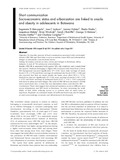Please use this identifier to cite or link to this item:
http://hdl.handle.net/10311/1137Full metadata record
| DC Field | Value | Language |
|---|---|---|
| dc.contributor.author | Maruapula, S.D. | - |
| dc.contributor.author | Jackson, J.C. | - |
| dc.contributor.author | Holsten, J. | - |
| dc.contributor.author | Shaibu, S. | - |
| dc.contributor.author | Malete, L. | - |
| dc.contributor.author | Wrotniak, B. | - |
| dc.contributor.author | Ratcliffe, S.J. | - |
| dc.contributor.author | Mokone, G.G. | - |
| dc.contributor.author | Stettler, N. | - |
| dc.contributor.author | Compher, C. | - |
| dc.date.accessioned | 2013-05-14T11:57:19Z | - |
| dc.date.available | 2013-05-14T11:57:19Z | - |
| dc.date.issued | 2011-08 | - |
| dc.identifier.citation | Maruapula, S.D. et al (2011) Short communication socioeconomic status and urbanization are linked to snacks and obesity in adolescents in Botswana, Public Health Nutrition, Vol. 14, No. 12, pp. 2260-2267 | en_US |
| dc.identifier.issn | 1368-9800 | - |
| dc.identifier.uri | http://hdl.handle.net/10311/1137 | - |
| dc.description.abstract | Objective: To describe patterns of food consumption associated with overweight\obesity (OW/OB) and their links to socio-economic status (SES) and urbanization. Design: A nationwide cross-sectional survey. Setting: Secondary schools in cities, towns and villages in Botswana, Africa. Subjects: A total of 746 adolescent schoolchildren. Results: OW/OB is associated with greater SES, city residence and a snack-food diet pattern. Students belonging to higher SES compared with those from a lower SES background reported significantly (P,0?01) more daily servings of snack foods (1?55 v. 0?76) and fewer servings of traditional diet foods (0?99 v. 1?68) and also reported that they ate meals outside the home more often (90% v. 72 %). Students in cities ate significantly (P,0?01) more servings of snacks (1?69 v. 1?05 v. 0?51) and fewer servings of traditional foods (0?67 v. 1?52 v. 1?61) compared with those in urban and rural villages. The odds of OW/OB were increased 1?16-fold with a snack-food diet, a result that was diminished when controlled for SES. Conclusions: These data suggest that nutritional transition occurs at different rates across urbanization and SES levels in Botswana. In cities, increasing the availability of fruit while reducing access to or portion sizes of snack items is important. Emphasis on continued intake of traditional foods may also be helpful as rural areas undergo economic and infrastructural development. | en_US |
| dc.language.iso | en | en_US |
| dc.publisher | PHN, http://journals.cambridge.org/action/displayJournal?jid=phn | en_US |
| dc.subject | Snacks | en_US |
| dc.subject | Traditional diet | en_US |
| dc.subject | Food patterns | en_US |
| dc.subject | Nutrition transition | en_US |
| dc.title | Short communication socioeconomic status and urbanization are linked to snacks and obesity in adolescents in Botswana | en_US |
| dc.type | Published Article | en_US |
| dc.link | http://journals.cambridge.org/download.php?file=%2FPHN%2FPHN14_12%2FS1368980011001339a.pdf&code=4cc538588848b603a69d566e33aeaf5e | en_US |
| Appears in Collections: | Research articles (Dept of Family and Consumer Sciences, formerly Home Economics Education) | |
Files in This Item:
| File | Description | Size | Format | |
|---|---|---|---|---|
| Maruapula_PHN_2011.pdf | 109.71 kB | Adobe PDF |  View/Open |
Items in DSpace are protected by copyright, with all rights reserved, unless otherwise indicated.
